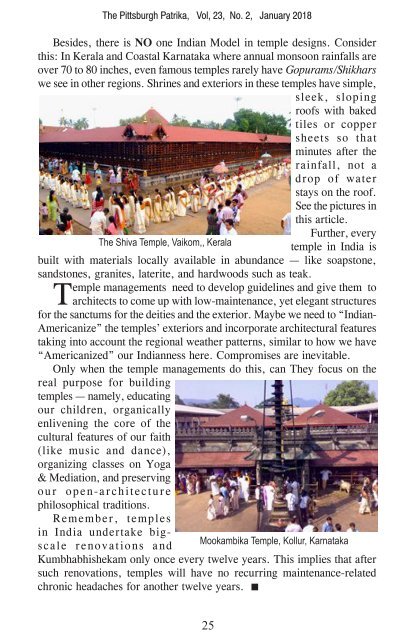Pittsburgh _Patrika_Jan-2018
You also want an ePaper? Increase the reach of your titles
YUMPU automatically turns print PDFs into web optimized ePapers that Google loves.
The <strong>Pittsburgh</strong> <strong>Patrika</strong>, Vol, 23, No. 2, <strong>Jan</strong>uary <strong>2018</strong><br />
Besides, there is NO one Indian Model in temple designs. Consider<br />
this: In Kerala and Coastal Karnataka where annual monsoon rainfalls are<br />
over 70 to 80 inches, even famous temples rarely have Gopurams/Shikhars<br />
we see in other regions. Shrines and exteriors in these temples have simple,<br />
sleek, sloping<br />
roofs with baked<br />
tiles or copper<br />
sheets so that<br />
minutes after the<br />
rainfall, not a<br />
drop of water<br />
stays on the roof.<br />
See the pictures in<br />
this article.<br />
Further, every<br />
The Shiva Temple, Vaikom,, Kerala<br />
temple in India is<br />
built with materials locally available in abundance — like soapstone,<br />
sandstones, granites, laterite, and hardwoods such as teak.<br />
managements need to develop guidelines and give them to<br />
Temple architects to come up with low-maintenance, yet elegant structures<br />
for the sanctums for the deities and the exterior. Maybe we need to “Indian-<br />
Americanize” the temples’ exteriors and incorporate architectural features<br />
taking into account the regional weather patterns, similar to how we have<br />
“Americanized” our Indianness here. Compromises are inevitable.<br />
Only when the temple managements do this, can They focus on the<br />
real purpose for building<br />
temples — namely, educating<br />
our children, organically<br />
enlivening the core of the<br />
cultural features of our faith<br />
(like music and dance),<br />
organizing classes on Yoga<br />
& Mediation, and preserving<br />
o u r o p e n - a r c h i t e c t u r e<br />
philosophical traditions.<br />
Remember, temples<br />
in India undertake bigscale<br />
renovations and<br />
Mookambika Temple, Kollur, Karnataka<br />
Kumbhabhishekam only once every twelve years. This implies that after<br />
such renovations, temples will have no recurring maintenance-related<br />
chronic headaches for another twelve years. •<br />
25


















